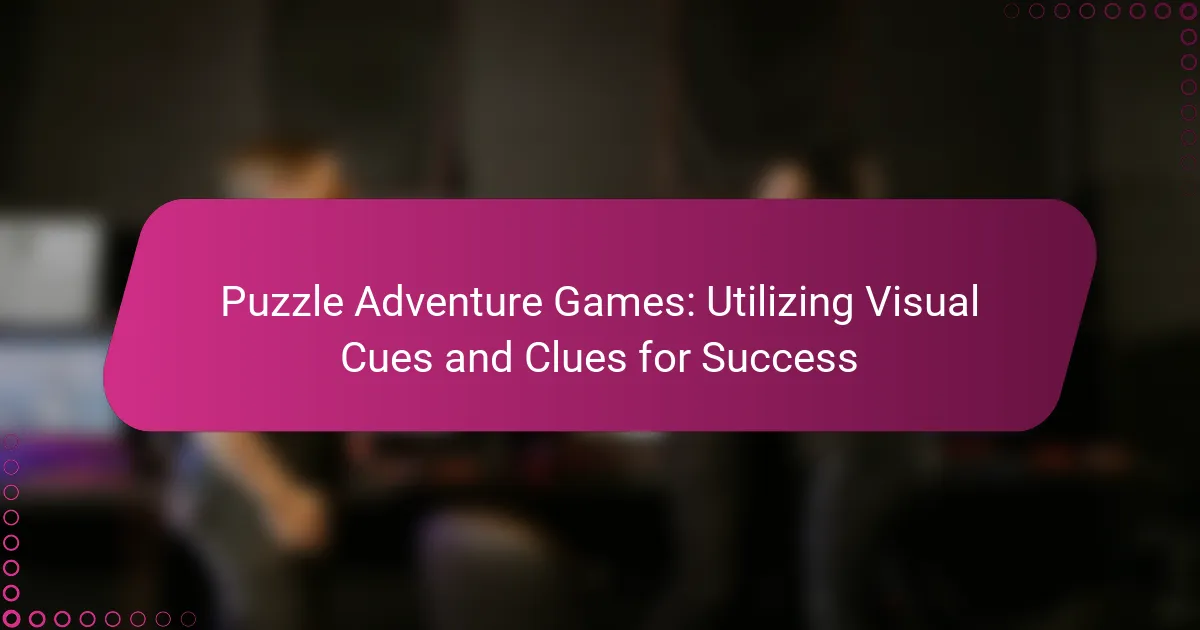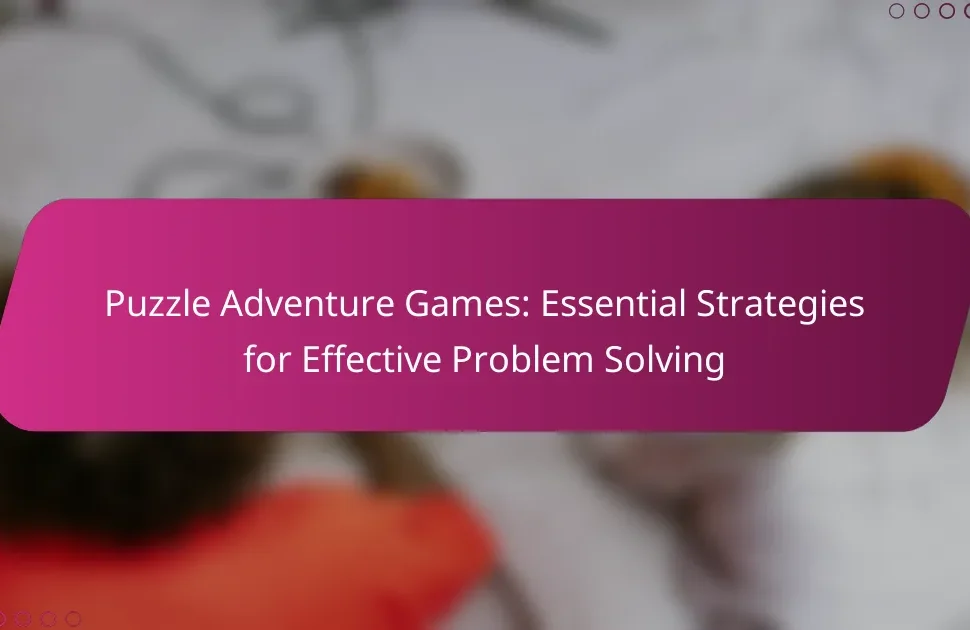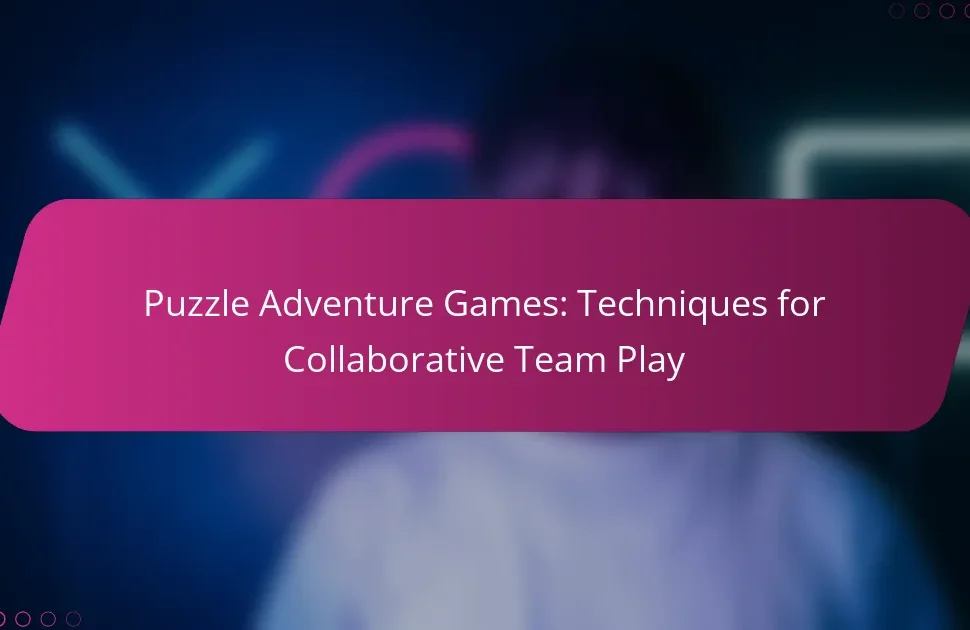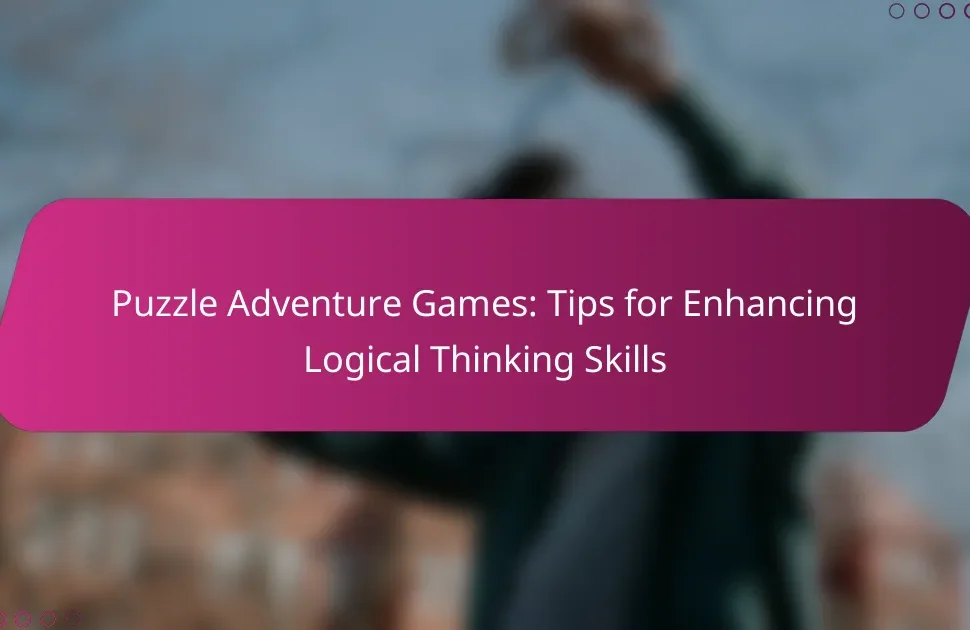Visual cues and clues play a crucial role in enhancing player success in puzzle adventure games. This article explores how effective visual cues guide player attention, the importance of clues in problem-solving, and the impact of game mechanics on gameplay. Additionally, it examines challenges players face when interpreting these cues and the influence of cultural contexts on their experience. Finally, emerging trends in game design that enhance visual engagement will be discussed.
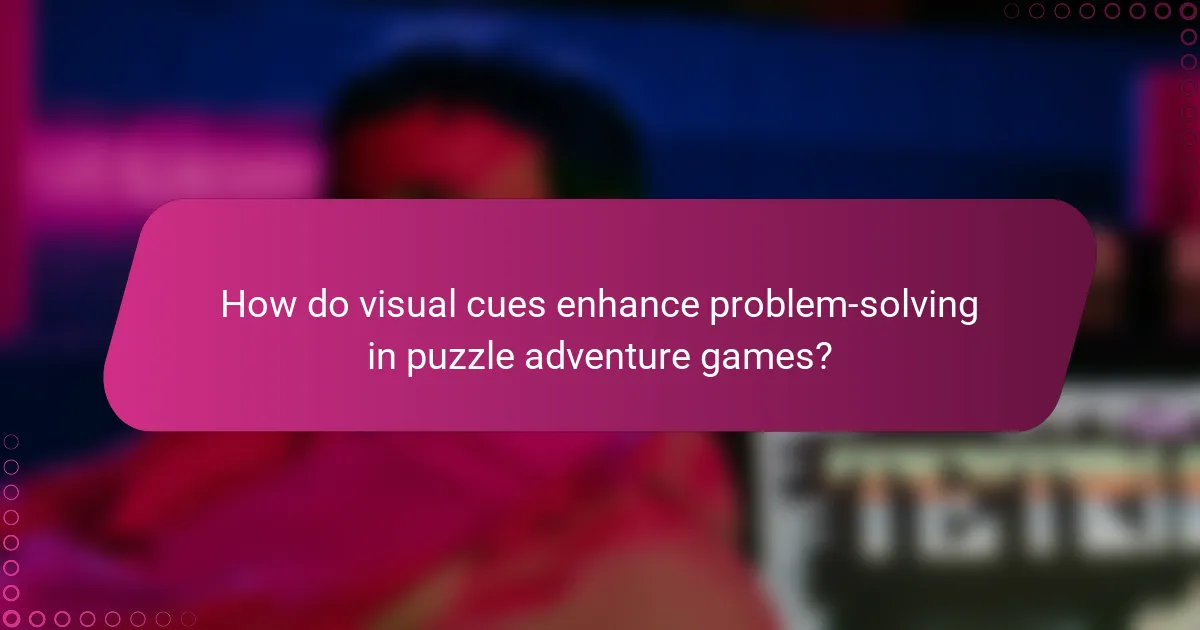
How do visual cues enhance problem-solving in puzzle adventure games?
Visual cues significantly enhance problem-solving in puzzle adventure games by guiding player attention and providing context. Effective visual cues, such as colour coding, shapes, and symbols, create intuitive pathways for players to follow. These cues help players identify important elements, discern clues, and make connections between objects in the environment.
For example, distinct colours can indicate interactive items, while symbols may represent specific actions required for progression. This visual language reduces cognitive load, allowing players to focus on solving puzzles rather than deciphering complex instructions. As a result, players experience increased immersion and satisfaction when successfully navigating challenges.
Incorporating visual cues not only improves gameplay mechanics but also fosters a deeper emotional connection to the game world. Players often feel a sense of accomplishment when they recognise and utilise these cues effectively, enhancing overall engagement and enjoyment.
What types of visual cues are commonly used?
Puzzle adventure games commonly use visual cues such as colour coding, symbols, and animations to guide players. Colour coding helps indicate interactive elements, while symbols can represent specific actions or items. Animations provide feedback on player actions, enhancing engagement and clarity. Other visual cues include environmental changes to signal progress and hidden objects that require exploration. These elements work together to create an immersive experience, facilitating problem-solving and navigation within the game.
How do players interpret visual cues differently?
Players interpret visual cues in puzzle adventure games based on their prior experiences and cognitive styles. Visual cues can guide players through challenges, but individual interpretation varies significantly. Some players may focus on colour contrasts and shapes, while others might prioritise spatial relationships or narrative context. This diversity in interpretation influences how effectively players solve puzzles and progress in the game. Understanding these differences can enhance game design, ensuring visual cues cater to a broader audience.
Which games exemplify effective use of visual cues?
Puzzle adventure games effectively use visual cues to guide players and enhance gameplay. Notable examples include “The Legend of Zelda: Breath of the Wild,” which employs colour-coded objects to signify interactable items, and “Gris,” which utilises a vibrant colour palette to convey emotional states and progress. “Myst” integrates environmental clues, encouraging exploration through visual storytelling. “The Witness” features intricate puzzles that rely on visual patterns and spatial awareness, reinforcing player engagement. Each game exemplifies unique visual strategies that contribute to immersive experiences.
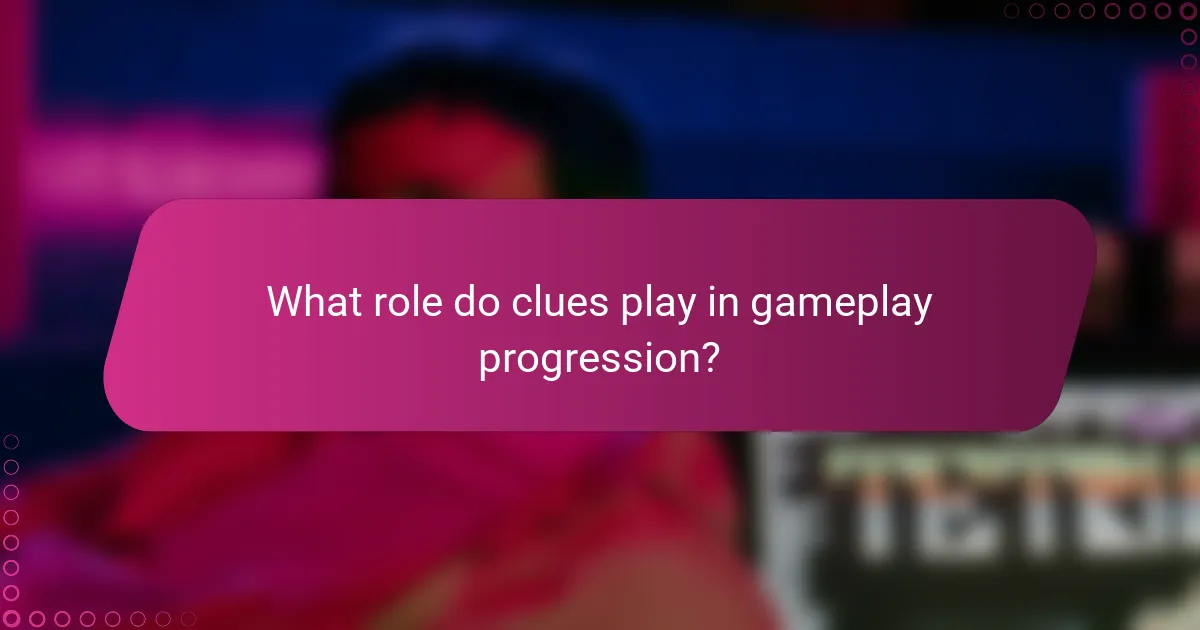
What role do clues play in gameplay progression?
Clues are essential for guiding players through puzzle adventure games. They enhance gameplay progression by providing hints that lead to problem-solving and exploration. Visual cues, such as highlighted objects or distinct colours, help players identify important elements in the environment. This engagement fosters critical thinking and encourages players to interact with the game world. Moreover, clues can vary in complexity, offering unique challenges that cater to different skill levels, thus enriching the overall gaming experience.
How are clues designed to challenge players?
Clues in puzzle adventure games are designed to challenge players by promoting critical thinking and problem-solving. They often incorporate visual cues, such as colour patterns or symbolic imagery, to guide players subtly. These clues may vary in complexity, requiring players to connect multiple elements to uncover solutions. Unique attributes, like environmental storytelling or interactive objects, enhance immersion and engagement, making the experience more rewarding. The balance between difficulty and accessibility is crucial, ensuring players remain motivated while still feeling challenged.
What are the psychological effects of clues on player engagement?
Visual cues and clues significantly enhance player engagement by fostering immersion and guiding problem-solving. These elements stimulate cognitive processes, encouraging exploration and interaction. Players experience increased motivation and satisfaction when effectively utilised. Engaging visual cues can evoke emotions, creating a deeper connection to the game narrative. This psychological engagement leads to prolonged playtime and a more fulfilling gaming experience.
Which popular puzzle adventure games feature innovative clue systems?
Several popular puzzle adventure games feature innovative clue systems that enhance gameplay. Notable examples include “The Witness,” which utilises visual puzzles that require players to observe their surroundings for clues. “Return of the Obra Dinn” employs a unique deduction system, where players piece together events from visual cues and clues. “Myst” offers immersive environments filled with hidden clues that players must explore to progress. “Grim Fandango” integrates a combination of inventory puzzles and environmental hints to guide players through its narrative. These games exemplify how innovative clue systems can elevate the puzzle adventure genre.
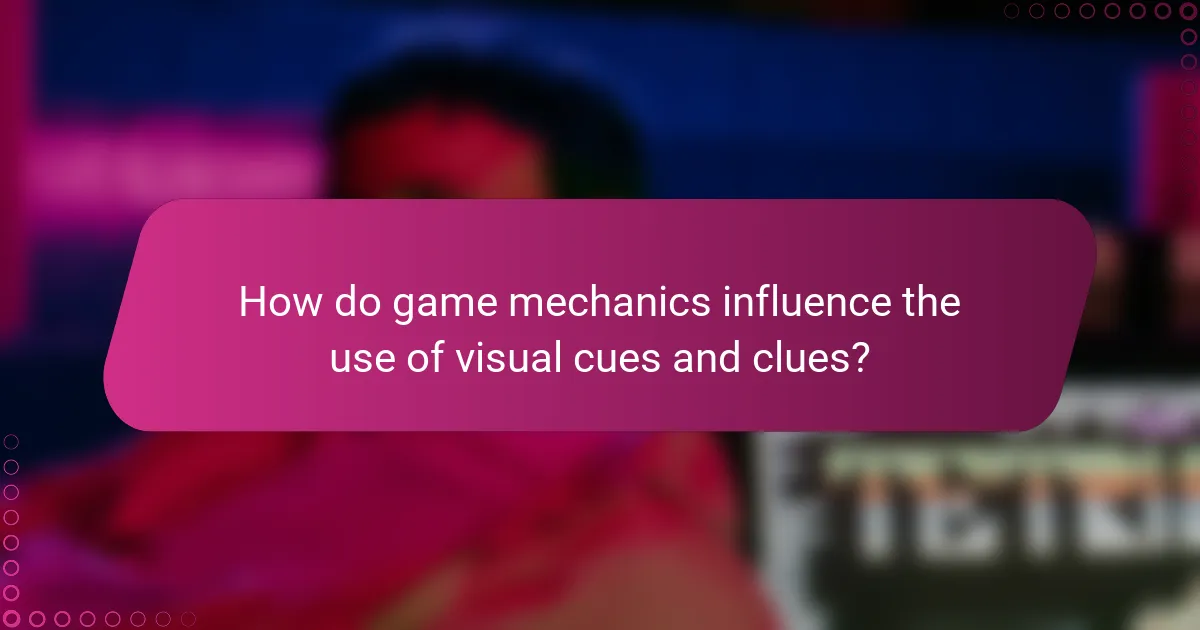
How do game mechanics influence the use of visual cues and clues?
Game mechanics significantly enhance the effectiveness of visual cues and clues in puzzle adventure games. These mechanics guide player interactions, making visual elements more intuitive and engaging.
Visual cues, such as colours and shapes, signal important information, while clues provide context for problem-solving. Game mechanics like progression systems reward players for discovering and utilising these cues effectively. For example, a hint system may unlock additional visual indicators as players advance, reinforcing learning and exploration.
Moreover, visual cues can vary based on unique attributes of game design. Some games may employ rare visual styles to create atmosphere, while others rely on common motifs to maintain familiarity. This variety influences player perception and strategy, ultimately affecting success in the game.
What common mechanics are found in successful puzzle adventure games?
Successful puzzle adventure games often incorporate visual cues, environmental storytelling, and logical progression. These mechanics guide players through challenges while enhancing immersion.
Visual cues include colour-coded objects or symbols that signal interactions, which help players identify important elements. Environmental storytelling uses background details to convey narratives, enriching the game world. Logical progression ensures puzzles build on previous knowledge, maintaining engagement and satisfaction.
Additionally, successful games often feature unique attributes like timed challenges or multi-layered puzzles that differentiate them and provide a compelling experience.
How do mechanics vary across different platforms?
Mechanics in puzzle adventure games vary significantly across platforms due to hardware capabilities and user interface design. Mobile devices often utilise touch controls, enhancing interactivity with visual cues. In contrast, console and PC platforms typically support more complex mechanics, including keyboard shortcuts and controller inputs.
Visual cues and clues adapt to these mechanics; for instance, mobile games may rely on larger icons for touch inputs, while PC games can employ subtle animations or hints that leverage higher graphic fidelity. Additionally, the pacing of gameplay may differ; mobile games often favour shorter sessions, while console and PC versions can offer more extensive narratives and puzzles.
Cross-platform games may integrate hybrid mechanics, ensuring a consistent user experience regardless of device. This adaptability is essential for maintaining player engagement across varying platforms.
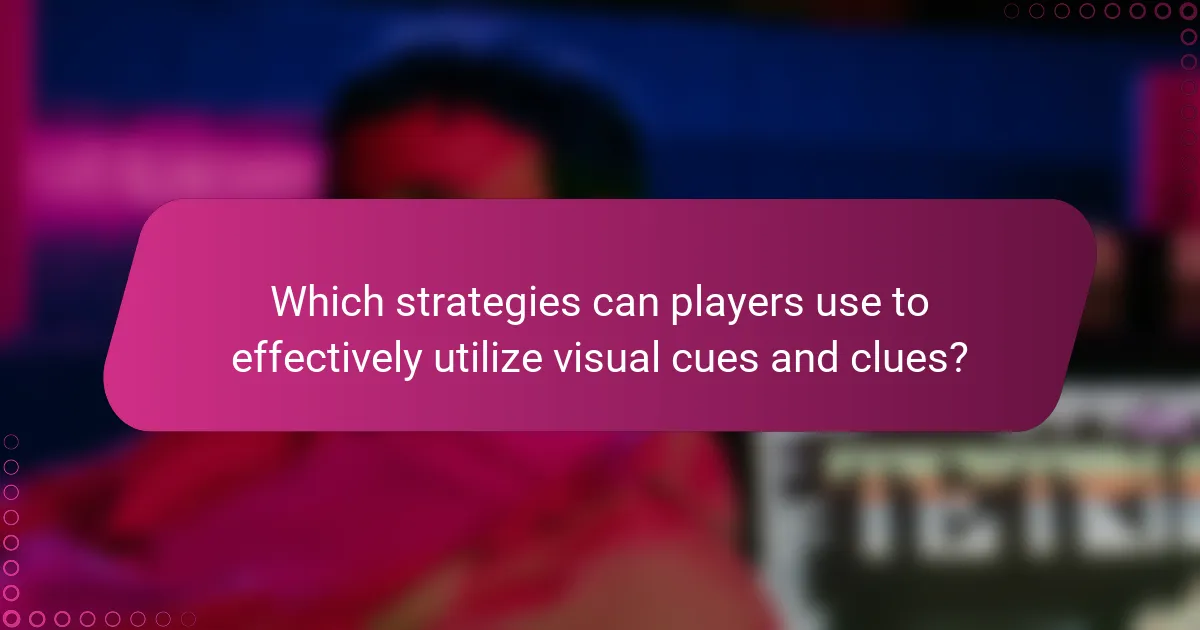
Which strategies can players use to effectively utilize visual cues and clues?
Players can effectively utilize visual cues and clues by observing their surroundings, analysing patterns, and experimenting with interactions. Recognising colours, shapes, and symbols can reveal hidden paths or items. Additionally, paying attention to environmental sounds and subtle animations enhances clue interpretation. Combining these strategies fosters exploration and problem-solving in puzzle adventure games.
What are the best practices for analyzing visual information?
To analyse visual information effectively in puzzle adventure games, focus on recognising patterns, colours, and shapes. Utilise visual cues to connect clues and solve challenges.
1. Observe the environment for hidden details that may provide hints.
2. Compare visual elements to identify similarities or differences that lead to solutions.
3. Use colour and shape associations to remember important clues.
4. Break down complex visuals into simpler components for easier analysis.
How can players improve their clue-finding skills?
Players can improve their clue-finding skills by practising observation, enhancing attention to detail, and using logical reasoning. Focusing on visual cues, such as colour patterns and object placements, helps identify important clues. Regularly engaging with diverse puzzle adventure games sharpens these skills. Players should also collaborate with others to share insights and strategies, which can reveal new perspectives on solving puzzles.
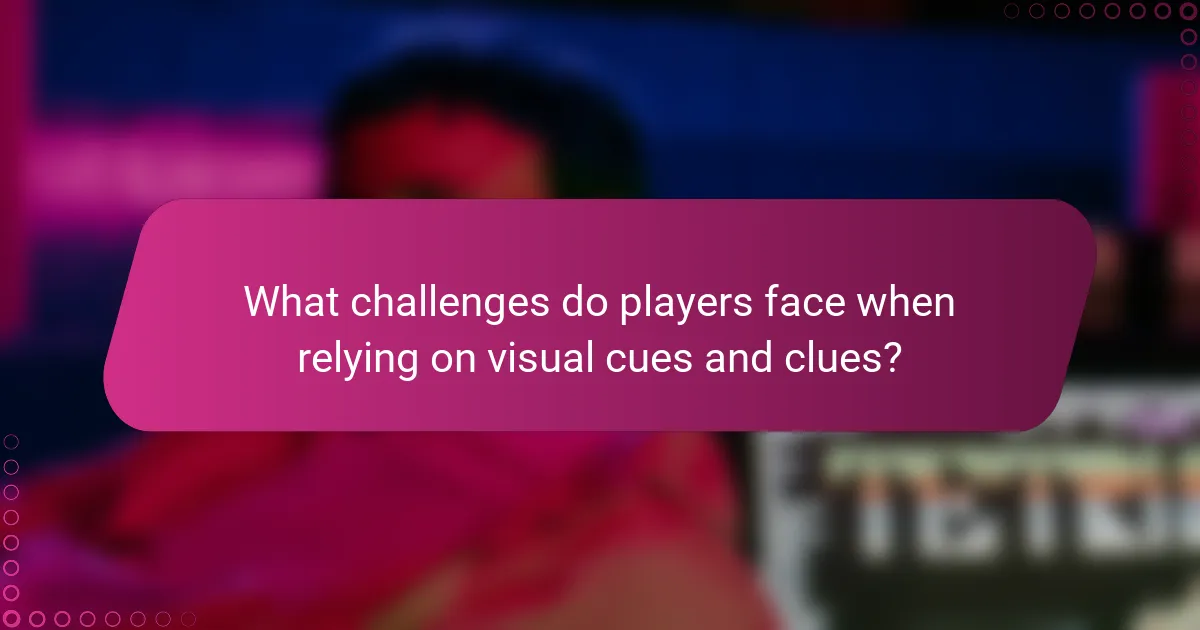
What challenges do players face when relying on visual cues and clues?
Players face several challenges when relying on visual cues and clues in puzzle adventure games. These challenges include misinterpretation of clues, environmental distractions, and varying levels of visual acuity among players. Misinterpretation can lead to incorrect solutions, while distractions may obscure important details. Additionally, players with different visual abilities may struggle to perceive cues equally, impacting their gameplay experience.
How can frustration from unclear cues affect gameplay?
Unclear cues can significantly hinder gameplay in puzzle adventure games, leading to frustration and decreased enjoyment. Players rely on visual cues to navigate challenges, and ambiguity can disrupt their problem-solving process. This confusion often results in wasted time and diminished satisfaction, as players struggle to interpret hints or clues effectively. Clear, well-designed visual cues enhance engagement and promote a seamless gaming experience, ultimately contributing to player success.
What are some common mistakes players make with visual cues?
Players often overlook key visual cues, leading to missed opportunities for success. Common mistakes include ignoring subtle hints, misinterpreting symbols, and failing to explore environments thoroughly. Players may also rush through puzzles without analysing visual elements, which can result in frustration and wasted time. Additionally, overlooking colour coding or patterns can lead to incorrect assumptions about the game’s mechanics or objectives.

How does player experience vary across different cultural contexts?
Player experience in puzzle adventure games varies significantly across cultural contexts due to differing interpretations of visual cues and clues. Cultural background influences problem-solving approaches, emotional responses, and engagement levels. For example, players from collectivist cultures may prioritise teamwork and collaboration, while individualistic cultures might emphasise personal achievement and autonomy. Additionally, familiarity with specific visual styles or narrative structures can affect how players decode clues. This diversity shapes overall enjoyment and success in gameplay, highlighting the importance of cultural sensitivity in game design.
What unique attributes do players from different regions bring to puzzle solving?
Players from different regions bring unique cultural perspectives and problem-solving strategies to puzzle adventure games. These influences enhance gameplay and creativity.
For example, players from Japan often excel in spatial reasoning, reflecting their architectural design principles. In contrast, Western players may approach puzzles with a focus on narrative and logic.
Additionally, players from Scandinavian countries might demonstrate a strong affinity for nature-themed puzzles, integrating environmental awareness into their strategies. This diversity enriches the gaming experience, fostering collaboration and innovation in solving challenges.
How do cultural differences influence game design?
Cultural differences significantly influence game design by shaping visual cues and clues in puzzle adventure games. Designers must consider cultural symbols, colours, and narratives that resonate with diverse audiences. For example, certain colours may symbolise luck in one culture and danger in another. This understanding enhances player engagement and success. Furthermore, cultural storytelling traditions can dictate how clues are presented, impacting the overall gameplay experience. Adapting to these differences allows for a more inclusive design that appeals to a global player base.
Which regions have the most innovative puzzle adventure games?
The most innovative puzzle adventure games are primarily found in North America and Europe. These regions host a vibrant gaming industry, fostering creativity and technological advancements. For instance, studios in the United States and Canada often lead in developing unique gameplay mechanics and engaging storylines. In Europe, countries like Sweden and Germany are recognised for their artistic designs and immersive experiences. The collaboration between indie developers and major studios further enhances innovation in this genre.
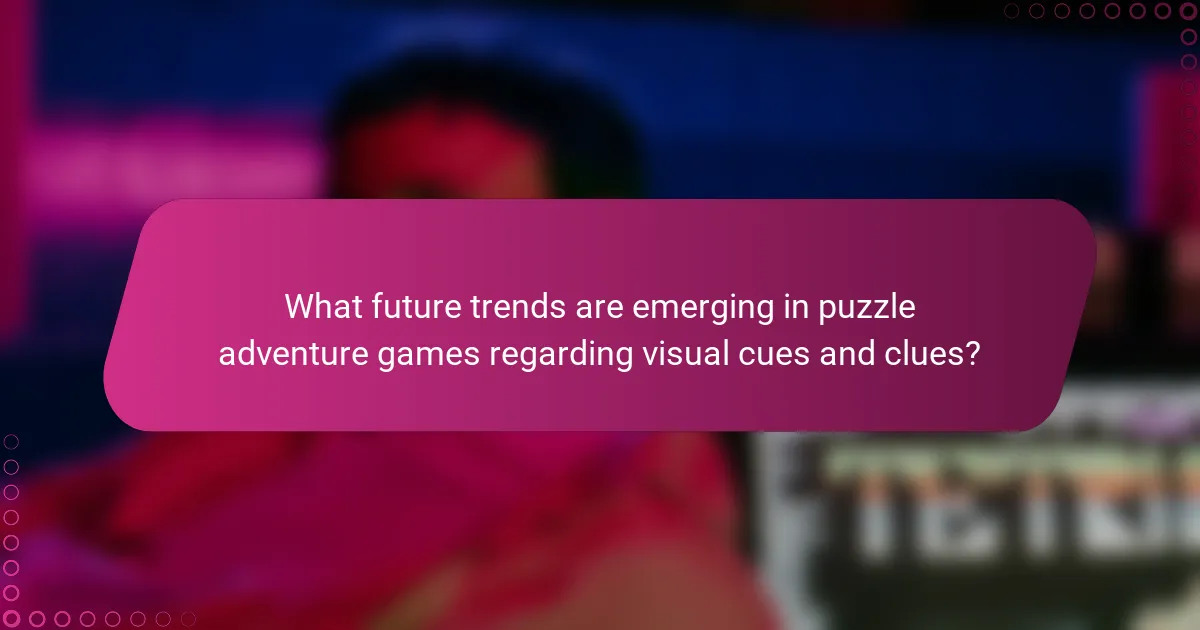
What future trends are emerging in puzzle adventure games regarding visual cues and clues?
Emerging trends in puzzle adventure games focus on enhanced visual cues and clues to improve player engagement. Developers are integrating dynamic visuals, such as interactive environments and adaptive lighting, which respond to player actions.
Additionally, augmented reality (AR) elements are being utilised to create immersive experiences that blend real-world environments with game puzzles. This unique attribute allows players to interact with clues in novel ways, enhancing problem-solving experiences.
Furthermore, AI-driven hints are becoming more common, offering personalised guidance based on player behaviour. This rare attribute tailors the gaming experience, ensuring that players remain challenged yet supported.
Overall, these trends emphasise a shift toward more intuitive and visually stimulating gameplay, fostering deeper connections between players and the game world.
How are technology advancements shaping gameplay?
Technology advancements are significantly enhancing gameplay in puzzle adventure games through improved visual cues and interactive clues. Enhanced graphics allow for more immersive environments, making it easier for players to identify essential elements. Advanced algorithms provide dynamic hint systems that adapt to player behaviour, ensuring a balanced challenge. Furthermore, the integration of augmented reality creates a unique gameplay experience, blending the real world with digital puzzles. These innovations not only increase engagement but also foster creativity and problem-solving skills among players.
What innovations are expected in the next few years?
Puzzle adventure games are expected to innovate through enhanced visual cues and interactive clues. These advancements will improve player engagement and problem-solving efficiency. For example, augmented reality can integrate real-world elements into gameplay, creating immersive experiences. Additionally, adaptive difficulty settings will tailor challenges to individual player skills, promoting sustained interest. Game developers will likely focus on collaborative features, allowing players to share hints and solutions in real-time, enriching the gaming community.
How can players stay ahead of trends in puzzle adventure gaming?
Players can stay ahead of trends in puzzle adventure gaming by actively engaging with community discussions and analysing game mechanics. Following influential developers on social media provides insights into upcoming features. Participating in beta tests allows players to experience new trends firsthand. Observing gameplay streams can reveal innovative strategies and visual cues. Joining forums and online groups fosters collaboration and sharing of tips. Tracking game updates ensures awareness of evolving gameplay dynamics.
What practical tips can enhance success in puzzle adventure games?
Utilising visual cues and clues effectively enhances success in puzzle adventure games. Focus on observing your surroundings to identify patterns, colours, and symbols that may provide hints.
1. Analyse your environment: Look for unusual shapes or colours that stand out.
2. Take notes: Document clues and their locations to avoid confusion later.
3. Interact with objects: Examine items closely; they may reveal hidden details or functions.
4. Use logic: Connect clues logically to solve puzzles, often requiring lateral thinking.
5. Collaborate: Discuss strategies with others to gain new insights and perspectives.
